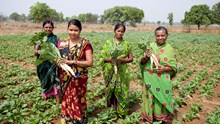
Rice remains the staple grain for more than half of the global population, particularly in Asian and African countries. Nations like India, China, Bangladesh, Nepal, and Thailand rely heavily on rice, not only as a dietary cornerstone but also as a vital economic crop supporting millions of farmers. In India, the top rice-producing states include West Bengal, Uttar Pradesh, Punjab, Andhra Pradesh, and Telangana, while Bihar, Tamil Nadu, Chhattisgarh, Odisha, and Haryana also play a significant role in the country’s overall production.
However, the impacts of climate change such as erratic rainfall patterns, prolonged droughts, floods, and increasing temperature fluctuations pose serious challenges to rice cultivation. To ensure food security and farmer profitability, the focus is shifting toward climate-smart agriculture and the development of resilient, high-yielding rice varieties that can thrive under such stressors.
10 Resilient Rice Varieties for Profitable Farming
Here are 10 promising rice varieties that have been specifically developed or improved to withstand environmental challenges while delivering profitability, sustainability, and high productivity:
1. DRR Dhan 100 (Kamala): Early-Maturing Yield Booster
Developed by the Indian Institute of Rice Research (ICAR-IIRR) in Hyderabad, DRR Dhan 100, also known as Kamala, is an improved version of the popular Samba Mahsuri variety. Kamala matures 20 days earlier than its parent, drastically reducing water usage and methane emissions, both critical factors in sustainable farming. Despite being early maturing, it retains the excellent grain quality of Samba Mahsuri and provides up to a 19% increase in yield.
2. Pusa DST Rice 1: Stress-Resilient Performer
From the Indian Agricultural Research Institute (IARI), New Delhi, Pusa DST Rice 1 has been bred from the MTU1010 cultivar. It is specifically designed to tackle drought and soil salinity, making it suitable for regions with poor-quality water or degraded soils. Field trials show yield improvements between 9.66% to 30.4% in saline and alkaline conditions. In general, it promises an overall production boost of up to 20%, making it ideal for climate-affected regions.
3. CR Dhan 108: Upland Drought Defender
This is a drought-tolerant variety tailored for upland cultivation in Odisha and Bihar, two Indian states frequently affected by irregular rainfall. CR Dhan 108 matures in about 112 days, making it ideal for early direct-seeded rice (DSR) systems. It helps reduce water dependency and fits well in rainfed farming models of eastern India.
4. Pusa Basmati 1509: Water-Saving Basmati
A favorite among Basmati growers, Pusa Basmati 1509 is an early-maturing, non-lodging, and non-shattering variety with significant agronomic and environmental benefits. It matures in 115 days, which is about 30 days earlier than the traditionally grown Pusa Basmati 1121. This early maturity translates into 3–4 fewer irrigations, 33% water savings, and earlier field availability for the next crop, particularly wheat. Farmers benefit from a reduced risk of residue burning, making it a cleaner, more sustainable option.
5. Pusa RH 60: Aromatic Hybrid for the Heartland
Another release from IARI, Pusa RH 60 is a high-yielding, short-duration hybrid known for its aromatic, long slender grains. It performs best in the states of Bihar and Uttar Pradesh, offering farmers both yield and grain quality while adapting well to changing climatic conditions.
6. Pusa Narendra KN1 and Pusa CRD KN2: Premium Kalanamak Upgrades
These are improved versions of the traditional Kalanamak variety, known for its aroma and cultural value in eastern Uttar Pradesh. Pusa Narendra KN1 and CRD KN2 have better resistance to pests and diseases and offer higher yields, enabling farmers to cultivate a premium grain with reduced input costs and greater profit margins.
7. Pusa-2090: Pollution-Fighter Variety
Pusa-2090 is a newly developed variety from IARI that significantly shortens the cultivation cycle to 120–125 days, compared to the 155–160 days required by the popular Pusa-44. With an average yield of 34–35 quintals per acre, this variety is not only high-yielding but also eco-friendly. It minimizes the need for stubble burning, a major contributor to air pollution in northern India and requires fewer irrigation cycles, making it a climate-resilient choice for progressive farmers.
8. Swarna-Sub1: Flood-Tolerant Lifesaver
A climate-resilient version of the widely grown Swarna (MTU7029) variety, Swarna-Sub1 has been enhanced to tolerate submergence, a critical feature for rainfed lowland areas frequently affected by flash floods. The plant matures in 140–145 days and has a short, bold grain structure. With its ability to survive up to 14 days under water, it is a game-changer for eastern India, especially in parts of West Bengal, Assam, Odisha, and Bihar.
9. Arize Hybrid: Yield Maximizer
Bayer’s Arize hybrid varieties are engineered for high performance, with 20–35% higher yields than conventional rice. These hybrids have been widely adopted in South and Southeast Asia for their stress tolerance, uniform maturity, and grain quality, making them popular among commercial farmers.
10. Samulai-1444: Superfine Market Favorite
Developed by Shakti Vardhak Hybrid Seeds, Samulai-1444 is another high-performing variety appreciated for its superfine grains and excellent market value. It matures in about 140–145 days, making it suitable for regions with a longer growing season. Samulai-1444 is gaining popularity among export-oriented Basmati growers and farmers seeking both quality and yield.
Way Forward
As climate change reshapes the agricultural landscape, the adoption of climate-smart rice varieties is no longer optional, it’s a necessity. The varieties listed above demonstrate that it is possible to strike a balance between profitability, resilience, and sustainability. What unites them is a shared vision: to conserve water, reduce emissions, withstand biotic and abiotic stresses, and increase yields, thereby securing both farmer livelihoods and food security.
For farmers looking to future-proof their paddy cultivation, these rice varieties represent smart investments that combine tradition with innovation.
















